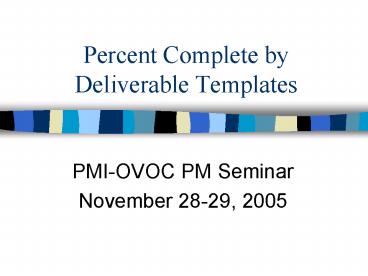Percent Complete by Deliverable Templates - PowerPoint PPT Presentation
1 / 25
Title:
Percent Complete by Deliverable Templates
Description:
Experience with DND, RCMP, various private companies (engineering, R&D, IT) ... If people can misreport PC, the schedule & PCO are less effective. Nov 2005 ... – PowerPoint PPT presentation
Number of Views:241
Avg rating:3.0/5.0
Title: Percent Complete by Deliverable Templates
1
Percent Complete by Deliverable Templates
- PMI-OVOC PM Seminar
- November 28-29, 2005
2
Wendi M.R. Smith, MBA, PMP
- Currently working for Finance/TBS.
- Experience with DND, RCMP, various private
companies (engineering, RD, IT). - Project Management Specialist
- Planning and scheduling
- Cost control and earned value (EV)
- Risk and issue management and
- EPA, PPA, SOR, PPRA, PMP, RMP, etc.
3
Topics in PMBOK
- Project Integration Management Develop
Preliminary Scope Statement - Project Scope Management Scope Planning,
Activity Definition, Scope Verification and Scope
Control - Project Time Management Schedule Control
- And, to a lesser degree
- Project Quality Management Perform Quality
Assurance and Quality Control
4
Percent Complete (PC) Templates
- Whats the problem
- PC difficult to standardize across groups
- PC difficult to verify independently
- Tasks progressed based on time passing or by
feel - PC shoots up to 90 and then inches to 91, 92,
etc. - Completion means different things to different
people and - Potential for evil (when building schedule,
weight minor or easy deliverables swamp
deliverables EV with LOE tasks).
5
Outcome
- Task end dates can be incorrect, affecting
critical path. - If EV is used, bad PC leads to bad analysis,
wrong conclusions. - If people can misreport PC, the schedule PCO
are less effective.
6
Intermediate steps
- For major deliverables types (like documents,
code modules, drawings) define intermediate steps
at which progress can be identified. - Keep schedule simple deliverable oriented
(either leave out LOE and unimportant tasks or
ensure that they are tagged or kept in a separate
WBS branch).
7
Examples
- 0-100
- Is standard across groups.
- Can be verified independently.
- BUT
- Understates actual progress even if everything
is going perfectly, the project looks worse than
it is raising false red flags. - 100 still needs definition.
8
Example of Document PC Template
- 5 when document has TOC.
- 10 when TOC approved by supervisor.
- 50 when document has all sections filled and
goes to peer review meeting. - 70 when document is approved by peers.
- 80 when distributed to supervisors for comments.
- 90 when document is signed by supervisors.
- 100 when filed.
9
(No Transcript)
10
During Initiation
- Develop Preliminary Scope Statement
- documents the project and deliverable
requirements, methods of acceptance, and
high-level scope control - Decide on whether to use EV, PC templates.
11
During Planning
- Agree on deliverable types
- major documents, which are approved outside the
organization - living documents
- major/ detailed drawings
- unit tested code modules
- test reports
- acceptance documents
- All these might have different PC templates.
12
During Planning (cont.)
- Agree on process for producing deliverables.
- Easy deliverables, that have been done over and
over again might just be written by one person,
then sent around for comments (RMP). - Strategic, or complex deliverables might benefit
from early collaboration, and lots of reviews.
13
During Planning (cont.)
- Agree on percent completes for verifiable
milestones. - Based loosely on effort required (not duration).
- Make sure that people are encouraged to finish
existing deliverables, rather than start new
ones. - Identify control points.
- Write it down.
- Get it approved.
- Subsequent changes are controlled.
14
During Planning (cont.)
- Agree on list of deliverables (baseline changes
are controlled). - Identify deliverable type for each.
- In Schedule Management Plan and schedule, ensure
provision is made to track by template. - Schedule should contain ALL major deliverables,
and represent the processes as agreed.
15
During Planning (cont.)
- Time phase completion of deliverables, and
baseline. - Optional Weight deliverables by importance or
by estimated number of person-days to complete
(deliverable measurement units).
16
During Execution
- Focus on quality of deliverables.
- Ensure that peer review and supervisor reviews
add value (not just arguments about grammar). - Look out for pro forma reviews.
17
Control
- Progress is identified during schedule updates or
team meetings. - Monitor control points (random or every document,
as required). - Co-ordinate with document manager, file clerk or
document repository.
18
Simplified Reporting
19
If using weighted DMUs
20
Advantages
- Focuses attention on the problem areas (exception
reporting). - Reporting not skewed by non-critical tasks.
- If you measure it, it will improve.
21
Things to look out for
- Too much credit for some milestones (especially
early ones). - Disincentives to complete deliverables.
- Too many intermediate steps overcomplicating the
process. - Lack of buy in among team, superiors.
- 5 problem.
22
When do you use this?
- Large number of similar deliverables across many
people, departments, or organizations. - Need for standardization, verification.
- Time sensitive projects.
- If EV is not possible because of problems
gathering timesheets. - With EV to define, standardize PC.
- Organization is already mature enough to have
processes, baseline control.
23
Dont bother using this if
- Team is small and homogenous.
- Number of deliverables is small.
- Deliverables are very dissimilar.
- Project/ organization is very immature (ad hoc
reporting, no processes).
24
Has anyone ever used this?
- Hibernia Topsides
- Very large engineering project 600 engineering
personnel, 150 procurement people, 12 planners. - Several engineering firms contributed personnel,
no standard methodology. - Encouraged standardized reporting across
stovepipes (with EV). - CPIC Renewal
- Large IT project, about 150 people
- 5 (later 4) separate companies plus RCMP, PWGSC,
etc. - Used DMUs to focus attention on deliverables (EV
lite).
25
Questions?
- Thank you.































